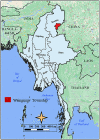This is a preprint.
Interventions for promoting patients' adherence to 14-day primaquine treatment in a highly malaria-endemic township in Myanmar: A qualitative study among key stakeholders
- PMID: 37720045
- PMCID: PMC10503836
- DOI: 10.21203/rs.3.rs-3312278/v1
Interventions for promoting patients' adherence to 14-day primaquine treatment in a highly malaria-endemic township in Myanmar: A qualitative study among key stakeholders
Update in
-
Interventions for promoting patients' adherence to 14-day primaquine treatment in a highly malaria-endemic township in Myanmar: a qualitative study among key stakeholders.Malar J. 2023 Oct 9;22(1):302. doi: 10.1186/s12936-023-04743-8. Malar J. 2023. PMID: 37814267 Free PMC article.
Abstract
Background: Plasmodium vivax malaria is considered a major threat to malaria eradication. The radical cure for P. vivax malaria normally requires a 14-day administration of primaquine (PQ) to clear hypnozoites. However, maintaining adherence to PQ treatment is a significant challenge, particularly in malaria-endemic rural areas. Hence, this study aimed to formulate interventions for promoting patients' commitment to PQ treatment in a highly malaria-endemic township in Myanmar.
Methods: A qualitative study was conducted in Waingmaw Township in northern Myanmar, where P. vivax malaria is highly endemic. Key stakeholders including public health officers and community members participated in focus group discussions (FGDs) and in-depth interviews (IDIs) in September 2022. Data were collected using validated guidelines, translated into English, and visualized through thematic analysis.
Results: Responsible individuals from different levels of the Myanmar National Malaria Control Program participated in the IDIs. Most of them reported being aware of the markedly increasing trend of P. vivax and the possibility of relapse cases, especially among migrants who are lost to follow-up. Workload was a key concern surrounding intervention implementation. The respondents discussed possible interventions, such as implementing directly observed treatment (DOT) by family members, piloting a shorter PQ regimen, expanding the community's malaria volunteer network, and strengthening health education activities using local languages to promote reasonable drug adherence. FGDs among community members revealed that although people were knowledgeable about malaria symptoms, places to seek treatment, and the use of bed nets to prevent mosquito bites, most of them still preferred to be treated by quack doctors and rarely used insecticide-treated nets at worksites. Many often stopped taking the prescribed drugs once the symptoms disappeared. Nevertheless, some respondents requested more bed nets to be distributed and health promotion activities to be conducted.
Conclusion: In rural areas where human resources are limited, interventions such as implementing family member DOT or shortening PQ regimens should be introduced to enhance the radical cure for the P. vivax infection. Disseminating information about the importance of taking the entire treatment course and emphasizing the burden of relapse is also essential.
Keywords: Compliance; Intervention; Myanmar; Plasmodium vivax; Primaquine; Qualitative research; Treatment adherence.
Conflict of interest statement
Competing interests The authors declare no competing interests.
Figures
Similar articles
-
Interventions for promoting patients' adherence to 14-day primaquine treatment in a highly malaria-endemic township in Myanmar: a qualitative study among key stakeholders.Malar J. 2023 Oct 9;22(1):302. doi: 10.1186/s12936-023-04743-8. Malar J. 2023. PMID: 37814267 Free PMC article.
-
A mixed methods study investigating factors affecting adherence to Plasmodium vivax malaria primaquine radical cure regimens among migrants along the Myanmar-Thailand border.PLOS Glob Public Health. 2025 Jan 16;5(1):e0003615. doi: 10.1371/journal.pgph.0003615. eCollection 2025. PLOS Glob Public Health. 2025. PMID: 39820011 Free PMC article.
-
The acceptability of targeted mass treatment with primaquine for local elimination of vivax malaria in a northern Myanmar township: a mixed-methods study.Parasit Vectors. 2021 Oct 24;14(1):549. doi: 10.1186/s13071-021-05064-y. Parasit Vectors. 2021. PMID: 34689796 Free PMC article.
-
Primaquine at alternative dosing schedules for preventing relapse in people with Plasmodium vivax malaria.Cochrane Database Syst Rev. 2019 Jul 5;7(7):CD012656. doi: 10.1002/14651858.CD012656.pub2. Cochrane Database Syst Rev. 2019. Update in: Cochrane Database Syst Rev. 2020 Aug 19;8:CD012656. doi: 10.1002/14651858.CD012656.pub3. PMID: 31274189 Free PMC article. Updated.
-
Primaquine treatment and relapse in Plasmodium vivax malaria.Pathog Glob Health. 2016;110(1):1-8. doi: 10.1080/20477724.2015.1133033. Epub 2016 Feb 18. Pathog Glob Health. 2016. PMID: 27077309 Free PMC article. Review.
References
-
- WHO . World Malaria Report 2022. Geneva, World Health Organization; 2022.
-
- Landier J, Parker DM, Thu AM, Lwin KM, Delmas G, Nosten FH, et al. Effect of generalised access to early diagnosis and treatment and targeted mass drug administration on Plasmodium falciparum malaria in Eastern Myanmar: an observational study of a regional elimination programme. Lancet. 2018;391(10133):1916–26. - PMC - PubMed
Publication types
Grants and funding
LinkOut - more resources
Full Text Sources




